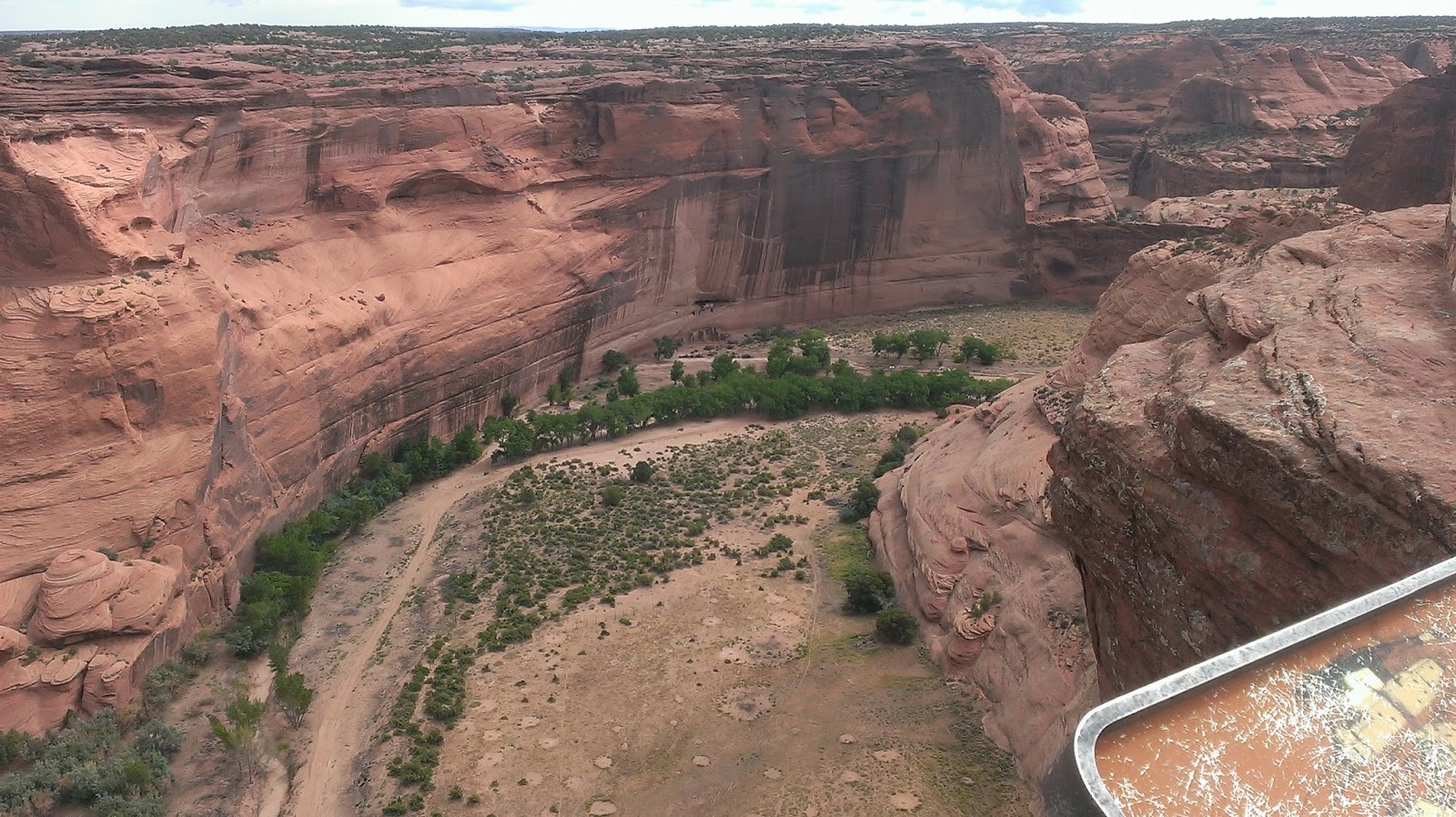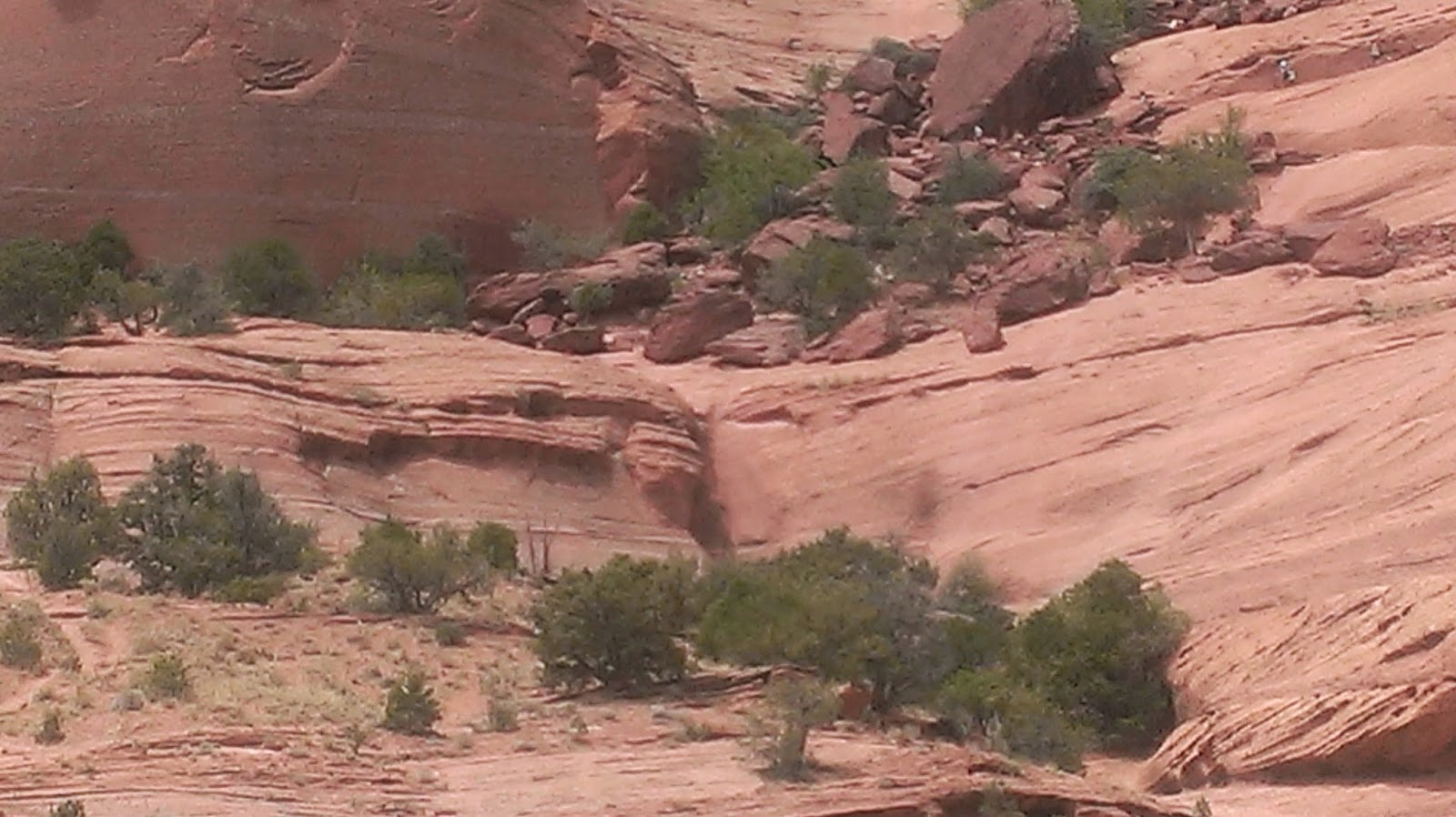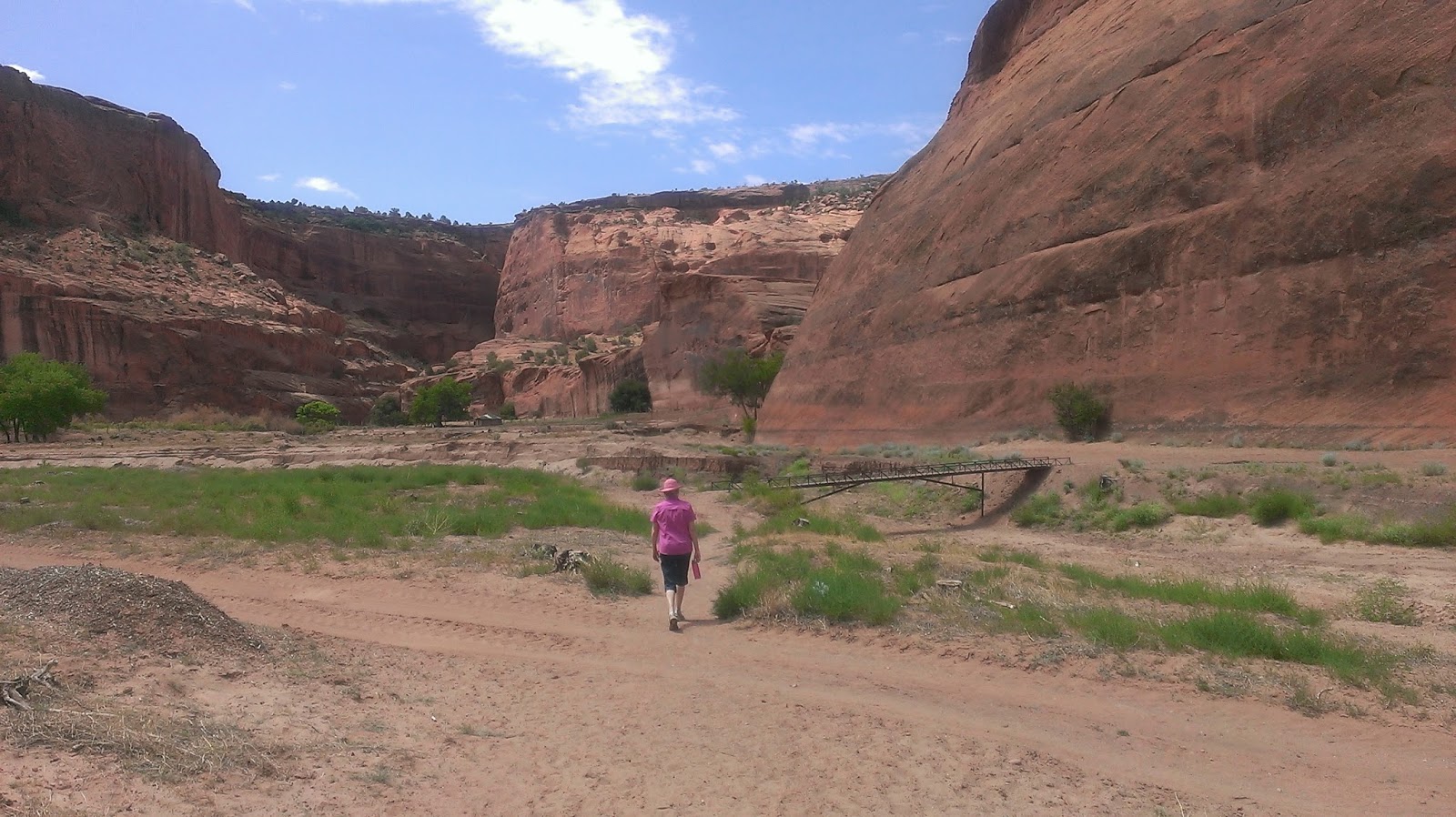We had reservations at the Holiday Inn in Chinle - although not the greatest hotel, it was the perfect location. From the hotel, you can see the entrance and visitor center for Canyon de Chelley National Monument. Our first stop was the visitor center where we checked out the Navajo hogan.
After checking out the visitor center, we headed out on the South Rim Road. Our plan was to visit the White House Ruins overlook and then see whether the trail was constructed in a way that would feel safe for me. We started with taking photos from the overlook. From here, the White House Ruins were barely visible - they are in the middle just about the trees.
I was able to zoom in with the camera and you can see the ruins.
As we walked around the overlook, the views were spectacular.
The Canyon is still inhabited by the Navajo, including farming and ranching. The White House Ruins trail is the only trail you wan hike without a licensed guide. There are restrictions on where you can go and of what you can take photos.
This is what the trail looked like from the overlook.
So we checked out the trail and decided we could do it.
The trail starts with the first of several tunnels.
In most places, the trail was four to six feet wide, with stairs cut into the de Chelley Sandstone rocks.
The rock is in layers, and due to uplift the layers go at unusual angles.
Once down in the valley, it was level and easy going.
Unlike other parks we have visited, here the ruins are completely fenced in - I could only get as close as about 100 yards.
When I zoomed in with the camera, I was able to see some of the pictographs that were between two two levels of the ruins.
Then it was time to climb back out of the canyon. The trail is 1.5 miles long and drops 600 feet in elevation. There are benches along the way, and resting in the shade or the tunnels made the climb up relatively comfortable - up and down took only about two hours.
After the White House Ruins, we checked out some other overlooks with great views of other parts of the canyon. The stop is called Sliding House Ruins. Unfortunately, the signage has been damaged by exposure to the elements.
At Sliding House ruins, you could see a sloped formation where they built houses that apparently would slide down and collapse - look closely it is in the middle at the bottom of the area in the shade.
As with other locations, the erosion of the soft de Chelley Sandstone creates some beautiful formations.
At Sliding House, we were several miles further up the canyon, and we saw more farming going on.
And of course, we had to take photos of each other.
We then went on to Spider Rock overlook. We could not figure out what the name referred to, but thought that maybe only spiders could climb some of the rock formations.
We then headed back to the visitor center and watched a 25 minute video narrated by some Navajos explaining why they find the canyon to be such an inspiration and a link to their history. One comment stuck with me - the narrator talked about having one foot in the tribal history and one foot in the present, and how tricky it was to navigate between both. It is difficult to retain and respect their heritage and customs, while at the same time deal with all the changes going on in today's world.
After checking out the visitor center, we headed out on the South Rim Road. Our plan was to visit the White House Ruins overlook and then see whether the trail was constructed in a way that would feel safe for me. We started with taking photos from the overlook. From here, the White House Ruins were barely visible - they are in the middle just about the trees.
I was able to zoom in with the camera and you can see the ruins.
As we walked around the overlook, the views were spectacular.
The Canyon is still inhabited by the Navajo, including farming and ranching. The White House Ruins trail is the only trail you wan hike without a licensed guide. There are restrictions on where you can go and of what you can take photos.
This is what the trail looked like from the overlook.
So we checked out the trail and decided we could do it.
The trail starts with the first of several tunnels.
In most places, the trail was four to six feet wide, with stairs cut into the de Chelley Sandstone rocks.
The rock is in layers, and due to uplift the layers go at unusual angles.
Once down in the valley, it was level and easy going.
Unlike other parks we have visited, here the ruins are completely fenced in - I could only get as close as about 100 yards.
When I zoomed in with the camera, I was able to see some of the pictographs that were between two two levels of the ruins.
Then it was time to climb back out of the canyon. The trail is 1.5 miles long and drops 600 feet in elevation. There are benches along the way, and resting in the shade or the tunnels made the climb up relatively comfortable - up and down took only about two hours.
After the White House Ruins, we checked out some other overlooks with great views of other parts of the canyon. The stop is called Sliding House Ruins. Unfortunately, the signage has been damaged by exposure to the elements.
At Sliding House ruins, you could see a sloped formation where they built houses that apparently would slide down and collapse - look closely it is in the middle at the bottom of the area in the shade.
As with other locations, the erosion of the soft de Chelley Sandstone creates some beautiful formations.
At Sliding House, we were several miles further up the canyon, and we saw more farming going on.
And of course, we had to take photos of each other.
We then went on to Spider Rock overlook. We could not figure out what the name referred to, but thought that maybe only spiders could climb some of the rock formations.
We then headed back to the visitor center and watched a 25 minute video narrated by some Navajos explaining why they find the canyon to be such an inspiration and a link to their history. One comment stuck with me - the narrator talked about having one foot in the tribal history and one foot in the present, and how tricky it was to navigate between both. It is difficult to retain and respect their heritage and customs, while at the same time deal with all the changes going on in today's world.









































No comments:
Post a Comment